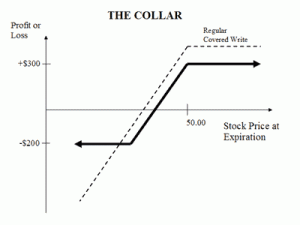A collar can be established by holding shares of an underlying stock, purchasing a protective put and writing a covered call on that stock. The option portions of this strategy are referred to as a combination. Generally, the put and the call are both out-of-the-money when this combination is established, and have the same expiration month. Both the buy and the sell sides of this spread are opening transactions, and are always the same number of contracts. In other words, one collar equals one long put and one written call along with owning 100 shares of the underlying stock. The primary concern in employing a collar is protection of profits accrued from underlying shares rather than increasing returns on the upside.
Technically, the collar strategy is the equivalent of a out-of-the-money covered call strategy with the purchase of an additional protective put.
The collar is a good strategy to use if the options trader is writing covered calls to earn premiums but wish to protect himself from an unexpected sharp drop in the price of the underlying security.
Limited Profit Potential
The formula for calculating maximum profit is given below:
- Max Profit = Strike Price of Short Call – Purchase Price of Underlying + Net Premium Received – Commissions Paid
- Max Profit Achieved When Price of Underlying >= Strike Price of Short Call
It is suited to investors who already own the stock and are looking to:
- Increase their return by writing call options
- Minimize their downside risk by buying put options
Covered calls are becoming very popular strategy for investors who already own stock. They sell out-of-the-money call options at a price that they are happy to sell the stock at in return for receiving some premium upfront. If the stock doesn’t trade above this level, the investor keeps the premium.
The problem with covered calls is that they have unlimited downside risk.
The solution to this is to protect the downside by buying an out-of-the-money put.
This increases the cost as you will have to outlay more to purchase the put and hence lowers your overall return.
